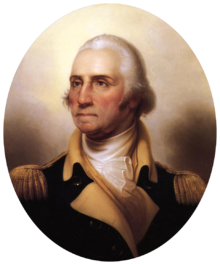Military career of George Washington
|
General of the Armies George Washington |
|
|---|---|

Portrait of George Washington in military uniform, painted by Rembrandt Peale.
|
|
| Born |
February 22, 1732 Westmoreland County, Virginia |
| Died | December 14, 1799 (aged 67) Mount Vernon |
| Allegiance |
|
| Years of service | 1752–1758 – British provincial militia 1775–1783 – Continental Army 1798–1799 – United States Army |
| Rank |
General of the Armies of the United States 1976–present (posthumous) |
| Commands held | Colonel, Virginia Regiment General and Commander-in-chief, Continental Army Commander-in-chief, United States Army |
The military career of George Washington spanned over forty years of service. Washington's service can be broken into three periods (French and Indian War, American Revolutionary War, and the Quasi-War with France) with service in three different armed forces (British provincial militia, the Continental Army, and the United States Army).
Because of Washington's importance in the early history of the United States of America, he was granted a posthumous promotion to General of the Armies of the United States, legislatively defined to be the highest possible rank in the US Army, more than 175 years after his death.
Virginia's Royal Governor, Robert Dinwiddie, appointed Washington a major in the provincial militia in February 1753. In that year the French began expanding their military control into the "Ohio Country", a territory also claimed by the British colonies of Virginia and Pennsylvania. These competing claims led to a world war 1756–63 (called the French and Indian War in the colonies and the Seven Years' War in Europe) and Washington was at the center of its beginning. The Ohio Company was one vehicle through which British investors planned to expand into the territory, opening new settlements and building trading posts for the Indian trade. Governor Dinwiddie received orders from the British government to warn the French of British claims, and sent Major Washington in late 1753 to deliver a letter informing the French of those claims and asking them to leave. Washington also met with Tanacharison (also called "Half-King") and other Iroquois leaders allied to Virginia at Logstown to secure their support in case of conflict with the French; Washington and Half-King became friends and allies. Washington delivered the letter to the local French commander, who politely refused to leave.
...
Wikipedia
